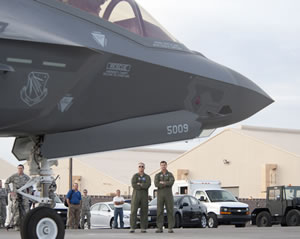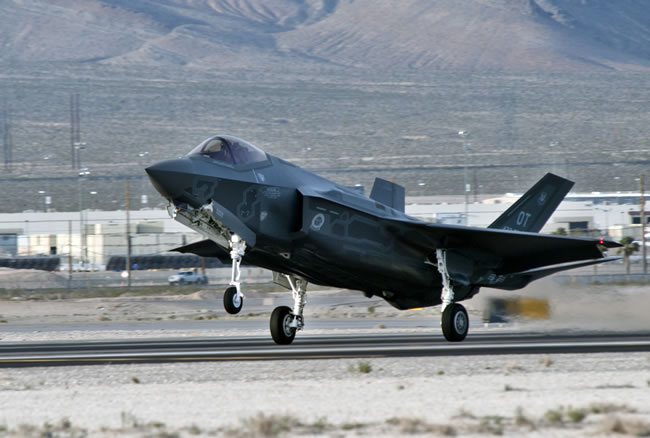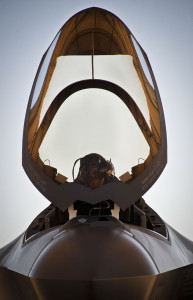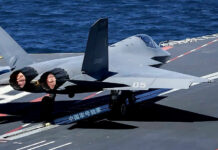

The F-35 Lightning II program at the Air Forces’ flight test center at Edwards FAB has entered a new phase of testing with the arrival of the first two operational test aircraft March 6, 2013. Team members from the 53rd Wing’s 31st Test and Evaluation Squadron, a tenant unit here, will determine how to best tactically operate the F-35A. Another 53rd Wing squadron, the 422nd Test and Evaluation Squadron (TES) at Nellis AFB, Nev., also received four F-35As on Tuesday (March 19, 2013) and will take part in the operational test process of the new aircraft.
“We’ve got a brand new tool with a whole new set of capabilities that has never been used by the combat air forces. We have to take that tool and find out the best way to utilize it, to go out and defeat an enemy on the battlefield – Lt. Col. Steven J. Tittel, the 31st TES commander
“As part of the Joint Operational Test Team, we take the aircraft hardware and software released from developmental test, our training from the 33rd Fighter Wing at Eglin (AFB, Fla.), the administrative and logistics support we get from the Joint Program Office and Lockheed Martin, and we integrate all of these disparate elements with maintenance practices, tactics, techniques and procedures required to create an incredibly lethal weapon system that can go out and win the nation’s wars,” said Lt. Col. Steven J. Tittel, the 31st TES commander. “We’ve got a brand new tool with a whole new set of capabilities that has never been used by the combat air forces. We have to take that tool and find out the best way to utilize it, to go out and defeat an enemy on the battlefield,” he continued.

With the F-35A slated to replace the A-10 and F-16, pilots selected for F-35 operational test and evaluation were hand-picked from among the best in the Air Force and bring a wide variety of expertise to the program. “Basically, this jet is going to encompass all of our air-to-ground roles and including some of our air-to-air roles as well. What they wanted was expertise from all those different platforms that will eventually be replaced by the F-35,” said Maj. Matthew L. Bell, the 31st TES Operations Flight commander. “The bottom line is we have all these jets with specialized capabilities and you want to make sure that if you’re eventually going to replace these airframes with one jet, none of that corporate knowledge is lost,” he added.
Bell, an A-10 Thunderbolt II pilot with more than 1,500 hours in the jet transitioned to the F-35 in December of 2012, bringing extensive knowledge of air-to-ground capabilities, close-air support, and forward-air-control to the operational test and evaluation program. Five additional pilots will be working alongside Bell with F-15E Strike Eagle and F-16 Fighting Falcon experience that adds a dimension of air-to-air expertise and an in-depth knowledge of deep strike capabilities. The 422nd TES is unique in that it is the Air Force’s only flying squadron to have all fighter aircraft with A-10s, F-15Cs, F-15Es, F-16s, F-22s, and now the nation’s newest airframe, the F-35.
What we do here over the next few years will absolutely play a large part in determining the jet’s effectiveness in real-world operations for the next 30 to 40 years
“We did that intentionally. The F-35 is designed to replace different legacy aircraft throughout the fleet. So we pulled together as much experience from different mission sets as we possibly could so we have a good baseline for evaluating the aircraft across all the missions it will be expected to perform in the future,” Tittel said. Together, their corporate knowledge will help shape combat tactics of the F-35A.
“We’re not necessarily trying to make this jet operate exactly like an F-15, F-16 or an A-10; we’re trying to figure out how to make an F-35 operate tactically. We’re trying to combine all that knowledge into a new set of tactics for the U.S.’ newest fighter and make sure that those tactics all make sense,” Bell said.
The Air Force also recruited top maintainers to support the F-35 operational test and evaluation efforts. These maintainers have been diligently preparing for the work ahead.
“We have a lot of top-notch maintenance troops out there that were highly sought after to come into this program. They have been going through a lot of training either across the ramp with the 461st Flight Test Squadron or down at Eglin AFB (Fla.), with a lot of hands-on academics,” Bell said. “Maintenance is out there and they’ve been aching to get their hands on the jets for a long time.”

In total for the 31st TES, there are approximately 150 personnel involved in operational test and evaluation for the F-35A. The 31st TES has grown over the past two years to include nearly 250 personnel; who can be found working in the combined test forces located throughout the base.
They also work on programs such as the B-1 Lancer, B-2 Spirit, RQ-4 Global Hawk and MQ-9 Reaper; in addition to the F-35 Lightning II.
While formalized testing is approximately a year and a half away, the necessary steps along the way will continue to benefit the F-35 operational test and evaluation program.
According to Bell, once the ground engine runs for maintenance are completed, he expects the flying to begin shortly thereafter. Initial flying operations will help pilots become familiar with their new airframe.
“Regardless of the experience we had before, this is still a new jet. In my mind, there is a large spin-up time to become experienced enough for the high-tempo scenarios we’re going to be involved in,” Bell said. “While actual formal testing will begin in about a year and a half, everything that we’re going to be doing up to that point will benefit the program.”
Formalized testing will evaluate the production-representative F-35A, as well as support equipment and the logistics supply system in an operationally representative environment; with the ultimate goal of determining whether or not the program is suitable and effective in a real-world combat environment.
It encompasses the aircraft’s survivability, as well as the ability to support and execute flight operations and maintenance at home and in deployed locations.
“We are the Air Force element of the larger joint and international test effort that will occur here at Edwards to get the F-35 through its initial test and evaluation, both for the Block 2 and Block 3 software,” Tittel said.
“We’re very much tactics developers, but we’re still evaluating the aircraft from an operational perspective; from the time we get it to the time we finally send it out as a completed product to the combat air forces,” he continued.
The men and women of the 31st TES will not only shape the future of air combat tactics for the F-35A, but they will ensure that the program is effective, sustainable and efficient in the real-world combat environment – a top priority for the Air Force of tomorrow.
“The Joint Operational Test Team has moved into a new phase. What we do here over the next few years will absolutely play a large part in determining the jet’s effectiveness in real-world operations for the next 30 to 40 years, at least,” Tittel said. “It’s a privilege to be on the leading edge of integrating new technologies into a combat airframe and then releasing it out to the combat air forces.”
The 31st TES and 422nd are geographically separated units of the 53rd Wing, headquartered at Eglin AFB.
The Air Force plans to base 36 F-35 fighter aircraft at Nellis between 2012 and 2020; By 2019 12 jets will support operational testing and tactics development and evaluation, in the following years 24 additional planes will be deployed with the weapon school training. Flight activities will occur at the base and the Nevada Test and Training Range north-west of Nellis.
by Laura Mowry, 412th Test Wing public affairs.
This article was first published by the US Air Force

















